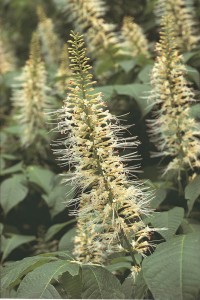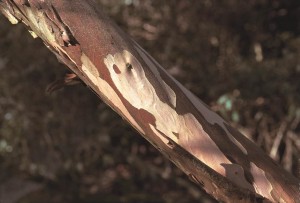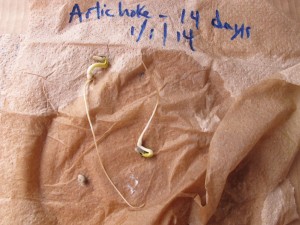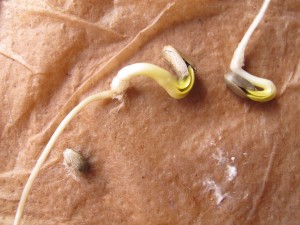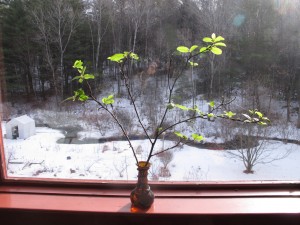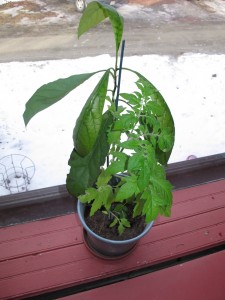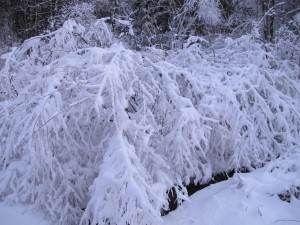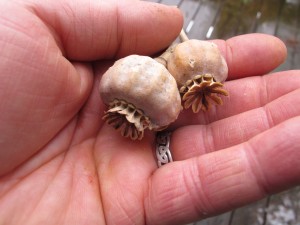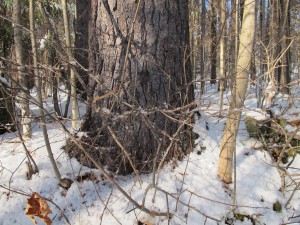Winter Reading
Going cross country skiing is generally my way of keeping cheery during long, cold winters. We started off the winter with plenty of snow, but lost most of it in January rains, and recently we’ve just had cold weather. It would be pretty easy for me to get the blues under these conditions, so I’ve been looking for ways to keep myself cheerful. One of the ways I do that is by learning about new plants, and dreaming of growing them once winter has ebbed.
Even though it came out in 2011, I only recently got my own copy of Dirr’s Encyclopedia of Trees & Shrubs. It’s 950 pages of information about 3700 species of woody plants – with more than 3500 good color photos. I have decided to read it cover to cover by April, though I am skimming the parts about plants for Zones 7 to 9. And since I own it, I am underlining and highlighting relevant info about plants that I want to try. I’d like to share a few of my ideas for purchases with you.
I’ve filled up most of my sunny places, so things that do well and bloom in shade are of interest to me. In the back of the book are lists of plants that do well in various conditions. It lists 225 plants that do well in shade (though some are outside our climatic zone).
First on my list of shade lovers to buy is bottlebrush buckeye (Aesculus parviflora). Dirr calls it “truly one of the best native shrubs for late-spring and early summer”. It is hardy to Zone 4 and “flowers almost as prolifically in shade as in sun.” The blossoms are 8 to 12 inch long, bottlebrush-shaped white inflorescences similar to those on horse chestnut trees– they are ‘cousins’ in the same genus. But it is an understory plant, growing to be just 8 to 12 feet high and 8 to 15 feet wide. And although it likes moist, well-drained soils best, it will grow almost anywhere.
Next, for both the bark and the blooms, I want to buy a Japanese clethra (Clethra barbinervis). It is a Zone 5 plant (good to minus 20) that requires shade and moisture-retentive soil for success. I have plenty of moist, shady areas near my stream that would easily harbor a 10 to 20 foot-tall shrub or small tree. The small blossoms are displayed in hanging panicles in July and August – a time when few other shrubs are blooming. The bark is exfoliating (it peels, exposing different colors of bark), which means it will be interesting to look at in winter.
I’ve always Franklinia (Franklinia alatamaha) for its bark which has interesting vertical fissures and for its 3-inch fragrant white blossoms in July and August. It will grow in shade and likes moist, well-drained soils. But Dirr warns that poorly drained soils generally prove fatal. It is a shrub or small tree, 10 to 20 feet high and 6 to 15 feet wide.
Franklinia was originally found in 1770 in Georgia, named after Ben Franklin, and disappeared from the wild by 1790. It is, according to Dirr, “a somewhat persnickety landscape plant.” Does that deter me? Well it has so far, but now that USDA has reclassified my area as Zone 5, and Dirr says this is a Zone 5 plant, maybe I should try it. I have not seen it succeed in New Hampshire or Vermont, which should warn me not to spend too much on my experiment. If you have grown it, please let me know how it did, and where you grew it.
Another tree that interests me is paw-paw (Asimina triloba). This is a small understory tree that produces edible fruit with a somewhat tropical flavor – a bit like bananas. I have only seen – and tasted – it in the Athens, Ohio area but Dirr says it is hardy to Zone 5. It does well in moist, well-drained soils in shade to full sun. Dirr says it will sucker (send out roots from the mother plant) so that it creates colonies. I have never seen the flowers, but he describes them as “lurid purple flowers that creep out of hairy brown buds before the leaves come out in April or May”.
Why is it that we see so few of these more unusual shrubs and trees? It may be that nurseries are unwilling to try things that no one has ever heard of. Or it may be that some growers have tried them, and the plants did not do well. Soil type (sandy, loam or clay) and soil pH (level of acidity) are important, but so are microorganisms. It may be that the bacteria and fungi in the soil along a stream bank in Ohio are very different than along my own stream.
My grandfather, John Lenat (1885 to 1967), was not an educated man, but a wise one who was an organic gardener long before it was fashionable. He told my sister once, “When you transplant something, bring along enough soil so that it will remember where it came from.” What he was saying, I think, is that you should bring along enough soil to inoculate your soil with the microorganisms from the site where it thrived.
Professor Dirr’s book is fun reading, too. He is opinionated and comes out with occasional wild statements – “with the right amount of imagination they (the flowers of Colutea arborescens) conjure visions of Yosemite Sam”, for example. So get your library to order a copy – or order your own.
Henry’s website is www.Gardening-Guy.com. He is the author of 4 gardening books.
Starting from Seeds
The seed catalogs have been arriving in my post office box for weeks now, and I‘ve been reading them and dreaming of fat, juicy tomatoes and sweet crunchy cucumbers. It’s too early to plant seeds indoors, but I’m getting ready now.
The first step in starting plants from seed is always to sort out what seeds I have, and to throw out the seeds that are past their “best used by” date. As a general rule I use three years as limit for keeping and using seeds. There are a few things that will last longer, and a few that are best bought each year. But 3 years is a good rule of thumb. You might want to test a few seeds you have left in the closet now to see if they will germinate.
Here is how to test for seed viability: count out 10 seeds and place them on a good tough paper towel, and label the towel with a waterproof marker or pencil. Dampen the towel, fold it over a few times and place it in a zipper bag. I left the bags open, thinking that a sealed bag might promote rotting of the seeds, but in one case, the paper towel dried out in places – which is sure death to seeds just starting. I checked the seeds after 1 week (nothing) and after 2 weeks. Some seeds may require even longer.
There are a few seeds that are worth buying every year as they do not germinate well, even on their second year. Among those are corn, onions, parsnips and parsley. And you can do a test germination if you wish for seeds that are 3 years old or more. This year I tried 2 kinds of onions (to test the 1-year rule), artichokes and celeriac (supposedly good for 5 years).
The onions germinated poorly, as forecast. 30% of one variety germinated, none of another. The artichokes germinated poorly, but the paper had gotten a bit dry. I only tried 5 seeds, and 2 of them germinated in the second week, sending out 3 inch roots and incipient leaves. I then planted those two seedlings in a large, deep pot – because I have a hard time killing plants. And artichokes take a long time to develop big plants, so I thought I’d let a few get an early start.
How you store your seeds makes a difference in viability, too. I store half-used seed packets in open zipper bags on a shelf in a closet. It gets neither excessively hot nor cold in the closet, and the humidity is neither high nor low, in general. Remember that seeds have living tissue inside, so overheating or drying out completely would be bad – though some seeds seem to have outer coverings as tough as any plastic. And freezing seeds does not seem to harm them, and that is the way most seed banks store their seeds.
Also at this time of year you can begin to assemble all the supplies and equipment needed for growing seedlings indoors. That means cleaning out all of lsat year’s pots and 6-packs for starting seedlings, and buying new ones as needed. As a general rule, the deeper the containers, the better. When buying 6-packs for your seeds, always get the biggest, deepest that you can. Instead of economizing and getting packs that are 72 to a tray, look for those that are just 36 to tray instead.
I also need to find (and clean up) any of the plastic domes I use to cover the trays of started seeds. These are reusable clear plastic covers that fit nicely over a tray and hold in moisture and heat. Seeds that dry out when just germinating do not survive, and these lids are great at containing moisture. I remove them once most seeds in a tray have started to grow.
Heat mats are also useful in starting seeds. I place seed trays on them to give a little bottom heat. Seeds germinate better and sooner with bottom heat, which makes sense. Seeds in the wild (without my help and supervision) shouldn’t germinate in winter – the seedlings would freeze. But warm soil tells the seeds that summer has arrived – hence the heat mats (to trick them). Available at garden centers.
Over the eons, plants have developed triggers for germination including temperature, presence of moisture, and, for some, sunshine. The photo-trigger means that seeds rototilled deeply won’t germinate – which is why I don’t rototill: weed seeds will germinate if brought to the surface.
Seedlings often do not do well if planted in garden soil indoors. There is no breeze and no direct sunshine in doors, so they may develop a fungal disease known as “damping off”. Outdoors it is not generally a problem. But it is best to buy “potting mix” or “seed starting mix”. This fluffy stuff is generally peat-based and sterile. I like to mix it 50-50 with compost, either my own or out of a bag. If you have it in your barn, be sure you thaw it out well in advance.
It’s still too early to plant most things. Onions and artichokes can be started in February, and sometimes I start hot peppers then. In general I like to start tomatoes and other annuals in early April so that they don’t get too big indoors. But it’s never too early to get organized and ready.
Henry Homeyer is a gardener, gardening teacher and consultant. His Web site is www.Gardening-Guy.com. he is the author of 4 gardening books and lives in Cornish Flat, NH
Getting through the Doldrums
When pruning a Merrill magnolia last November, I brought home a few stems that had nice fat flower buds and put them in a vase of water. I put them in a south-facing window and pretty much forgot about them. From time to time I admired the smooth gray bark and handsome branching patterns. But then in the first week of January, those stems developed lovely green leaves! And the flower buds are swelling and look as if they might bloom, too – but even if they don’t, my spirits are lifted by seeing some green leaves.
Forcing blossoms of tree branches (making them bloom early indoors) is normally something I do in March, when I am pruning apple trees. I always bring in some branches and enjoy both the leaves and flowers of stems I have cut. At that time of year the trees are already “thinking” about opening up their buds, and it only takes a week or two for them to open up on a sunny windowsill.
But this year, I am going to cut apples, forsythia, lilacs and other spring-blooming trees and shrubs starting now. Each week I shall snip a few branches and experiment with forcing. I have never tried forcing lilacs, for example, and since they are mid-to late-spring bloomers, I would normally hold off until nearer the time that they normally break dormancy –perhaps in April. But why not try now? I have read that one can encourage branches to break dormancy by submerging them entirely in a bathtub of water and will give that a try.
When you select branches for forcing, be sure to pick some that have flower buds. Flower buds are generally fatter than leaf buds. On apple trees, flowers are generally found on fruit spurs. These are 2- or 3-inch long stems that end in fat buds. The buds contain both leaf and flower buds. For many varieties, fruit spurs must be more than a year old in order to produce flowers (and hence fruit). Last year’s water sprouts (vertical whips) on apples will produce leaves but not flowers.
Almost any tree can be forced, but many do not have flowers that are colorful, so we often ignore them. Do you know what a maple or poplar blossom looks like? Their small green flowers are not much appreciated – and I have never cut them to put in a vase. You certainly recognize pussy willows as signs of spring, but do you think of those furry fellows as flowers? They are flowers, and can give me as much pleasure in February as my roses will later on.
For best results, cut stems of trees according to their natural schedule. That means picking early bloomers now, and later bloomers in February and March. Here is a rough schedule: In January cut forsythia , willows and poplars. In early February cut red maples, alder, quince, birch and cherries. Later in February try rhododendrons, azaleas and pussy willows. Then in March try cutting branches of hawthorns, shrub honeysuckles, apples, crabapples, mockorange, lilacs, and spirea.
Elsewhere in the house I was recently surprised by a tomato plant that appeared in a pot where I have an avocado growing. The avocado was one that I dug out of the compost pile last fall – along with a tomato seed, apparently. Most grocery store avocados do not have viable seeds, as the seeds need to be fresh (picked within 3 weeks of planting) in order to grow.
I remember as a boy suspending an avocado seed in a glass of water by toothpicks. It sent roots down into the glass, and then sent up a stem. I planted the seedling in a pot, creating a nice houseplant with glossy green leaves. But since the avocado industry now stores and sells avocados all year, the seeds are usually too old to grow. But I guess last summer I threw a few fresh avocado seeds into the compost because three seeds grew!
But what about that orphan tomato growing with my avocado? I am going to give it every benefit. I have heard about people who have gotten tomatoes to bloom and produce fruit indoors in winter, though I have never done it. To help mine along I have hung a light over it in the window where it is growing. I am using an LED light that uses very little energy and produces a lot of light from its 45 little LED bulbs. It’s produced by Sunshine Systems (www.sunshine-systems.com) and uses just 28 watts of power while providing the light of a 250 watt hps lamp.
I realize that my tomato might not produce tasty fruit even if I get some. It all depends on the seed: it will be fine if it came from an heirloom tomato (which is mostly what I grow), but if it’s from a hybrid tomato plant, it might produce an undesirable fruit. Hybrids most often revert to the parent types, which may not be tasty. Still … it’s winter, and I’m game to try almost anything to feel like a gardener.
Henry Homeyer is the author of 4 gardening books and lectures on gardening throughout New England. He can be reached at henry.homeyer@comcast.net.
Gardening in January
For most of us, gardening in January is limited. Water the houseplants. Read the seed catalogs. Dream of flowering shrubs to add to the perennial border – that sort of thing. But there are activities we can do now– and should.
In late December we had 4 inches of heavy wet snow, followed by cold weather. This resulted in heavy globs of snow and ice frozen to many of our decorative trees and shrubs, and considerable damage. In addition to broken limbs, many branches were bent to the ground – and might stay that way unless we do something.
I went around my garden to knock off snow, or to shake it loose from shrubs that were bent over or burdened by the snow. Some have responded nicely, popping back to their standard shapes, while others may not fully recover until spring.
Of those that bounced back, there is my arctic blue willow (Salix purpurea ‘Nana’). This shrub has varied in its form over the years: for several years it was a classic ‘Nana’ – which means that it was a slow-growing dwarf form. But since I started pruning it a few years ago (or perhaps it hit a teenage growth spurt) it has responded by putting out lots of new growth, sometimes growing as much as 3 feet in a season. I didn’t prune it last fall because the new growth was so distinctive: lots of fine vertical stems in close proximity to each other. It reminds me of a punk rockers hairdo – straight up.
That willow was bent over so that the tips of its branches (which were 6 feet tall or so) touched the ground. I went around gathering armfuls of branches and shaking them gently to shed the snow. The branches did not pop back up and I was worried that the shape of the shrub would be permanently changed. But a couple of days later it is back to its original shape.
I keep my Christmas tree up and in the house until it becomes almost dangerously dry, ready to explode at the first sign of a spark. I consider it a “winter tree” in the New Year and revel in its lights and all the memories the ornaments conjure up. (I have a felt and tinsel Santa from my Mom’s tree that probably came from Germany with her parents around 1900). But if you take down yours before the Ground Hog Day, you can use the branches in the garden.
Evergreen boughs are great to use to protect tender perennials and shrubs. Although we have had good snow cover so far this year, if we get a January thaw followed by very cold nights, frost and cold may penetrate the soil deeply and may kill the roots of tender plants. To prevent that, provide some insulation, particularly for new perennials and shrubs. Place branches over the plants, and then some mulch hay or straw over that. It’s like tucking in your baby at night.
A brief explanation is in order about why some tender shrubs and vines fail to bloom some years. Woody plants make their buds either the summer before and bloom early in the spring or summer on “old wood”. Or they make their buds in spring for summer or fall blooms on “new wood” that grows after winter is over. In the first category are forsythia, lilacs, blueberries and most wisteria. In the second are hydrangeas, summer clethra and Seven Sons Flower tree.
Shrubs that bloom on old wood can lose their blossoms when a cold, strong wind burns off the flower buds. The ‘Endless Summer’ blue hydrangea is sold as a plant that will bloom in June and repeat blooms all summer. But that only happens if the flower buds survive the winter, and often they do not – delaying bloom until late summer on new wood.
Another gardening activity I do when temperatures are below zero is to plant a few poppy seeds outdoors in the snow. I save the seed heads of annual poppies each year in a plastic bag. Then just when winter seems the most oppressive, I sprinkle seeds on the snow over a flower bed that has been cultivated and loose soil on its surface.
Even a cold winter sun will heat up a black poppy seed enough to allow it to melt its way through the snow. If I sprinkle a hundred seeds, at least a few will eventually lodge in suitable places and grow next summer. It’s no work, great fun, and it makes spring seem like a word that is within the realm of the possible -even if the thermometer is below zero.
Henry Homeyer is the author of 4 gardening books and a children’s novel, Wobar and the Quest for the Magic Calumet. Reach him at henry.homeyer@comcast.net or PO Box 364, Cornish Flat, NH 03746.



